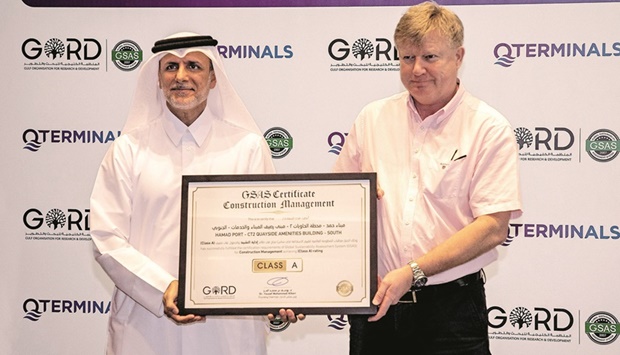* QTerminals Container Terminal 2 receives GSAS sustainability certifications
QTerminals Container Terminal 2 (CT2) at Hamad Port has been awarded the internationally recognised sustainability certifications under the Global Sustainability Assessment System (GSAS).
Awarded by the Gulf Organisation for Research and Development (Gord), the project has received GSAS Construction Management certification with a Class A rating.
Within the terminal, QAS South Building has received GSAS 3 Stars certificate under design and build, offices scheme. In addition, the terminal is undergoing GSAS design and build scheme for the whole of the Phase 1 and 2 areas.
Demonstrating outstanding on-site practices during the construction management phase, CT2 is the first project to receive GSAS construction management certificate under GSAS 2019, which represents a comprehensive sustainability assessment framework for rating onsite practices developed by contractors.
“In today’s globalised world, ports play an integral role in shaping the economic development of nations. At the same time, terminal operators are the ones that add value and streamline supply chains. QTerminals has an enormous responsibility to optimise and expand Hamad Port’s operational capacity to better connect Qatar with the international market,” said Dr Yousef al-Horr, founding chairman of Gord.
Neville Bissett, QTerminals Group chief executive, said, QTerminals “we understand the importance and the impact of new developments on the environment and we will continue to drive these initiatives in all our future projects.”
GSAS-CM Class A rating attained by CT2 represents one of the highest levels awarded to projects that incorporate sustainability best practices during construction through land preservation mechanisms, efficient traffic management, energy and water conservation, waste management, dust control, responsible stockpiles management, recycling and reuse of materials, health and safety measures and worker conditions.
To divert construction waste of 132,000 cubic metres from landfills, CT2 2 development reused 112,000 cubic metres of the excavated material for backfilling on site and reused the surplus 20,000 cubic metres to fill and level an adjacent plot, thereby saving tons of carbon dioxide emissions that would have resulted from transport and disposal of excavated materials.
Water resulting from dewatering activities was reused for dust control on site. Similarly, to ensure biodiversity preservation, surplus water from dewatering operations was treated before being discharged into the sea. This move was aimed at minimising the impact of construction activities on marine life.
In the long run, sustainability features of CT2 and its facilities will extend beyond design and construction phases. In the operational phase, the project will further enhance its environmental performance with the implementation of GSAS operations certification, including the use of fully sustainable LED high light masts and regenerated power from the STS cranes during operations.
Awarded by the Gulf Organisation for Research and Development (Gord), the project has received GSAS Construction Management certification with a Class A rating.
Within the terminal, QAS South Building has received GSAS 3 Stars certificate under design and build, offices scheme. In addition, the terminal is undergoing GSAS design and build scheme for the whole of the Phase 1 and 2 areas.
Demonstrating outstanding on-site practices during the construction management phase, CT2 is the first project to receive GSAS construction management certificate under GSAS 2019, which represents a comprehensive sustainability assessment framework for rating onsite practices developed by contractors.
“In today’s globalised world, ports play an integral role in shaping the economic development of nations. At the same time, terminal operators are the ones that add value and streamline supply chains. QTerminals has an enormous responsibility to optimise and expand Hamad Port’s operational capacity to better connect Qatar with the international market,” said Dr Yousef al-Horr, founding chairman of Gord.
Neville Bissett, QTerminals Group chief executive, said, QTerminals “we understand the importance and the impact of new developments on the environment and we will continue to drive these initiatives in all our future projects.”
GSAS-CM Class A rating attained by CT2 represents one of the highest levels awarded to projects that incorporate sustainability best practices during construction through land preservation mechanisms, efficient traffic management, energy and water conservation, waste management, dust control, responsible stockpiles management, recycling and reuse of materials, health and safety measures and worker conditions.
To divert construction waste of 132,000 cubic metres from landfills, CT2 2 development reused 112,000 cubic metres of the excavated material for backfilling on site and reused the surplus 20,000 cubic metres to fill and level an adjacent plot, thereby saving tons of carbon dioxide emissions that would have resulted from transport and disposal of excavated materials.
Water resulting from dewatering activities was reused for dust control on site. Similarly, to ensure biodiversity preservation, surplus water from dewatering operations was treated before being discharged into the sea. This move was aimed at minimising the impact of construction activities on marine life.
In the long run, sustainability features of CT2 and its facilities will extend beyond design and construction phases. In the operational phase, the project will further enhance its environmental performance with the implementation of GSAS operations certification, including the use of fully sustainable LED high light masts and regenerated power from the STS cranes during operations.

